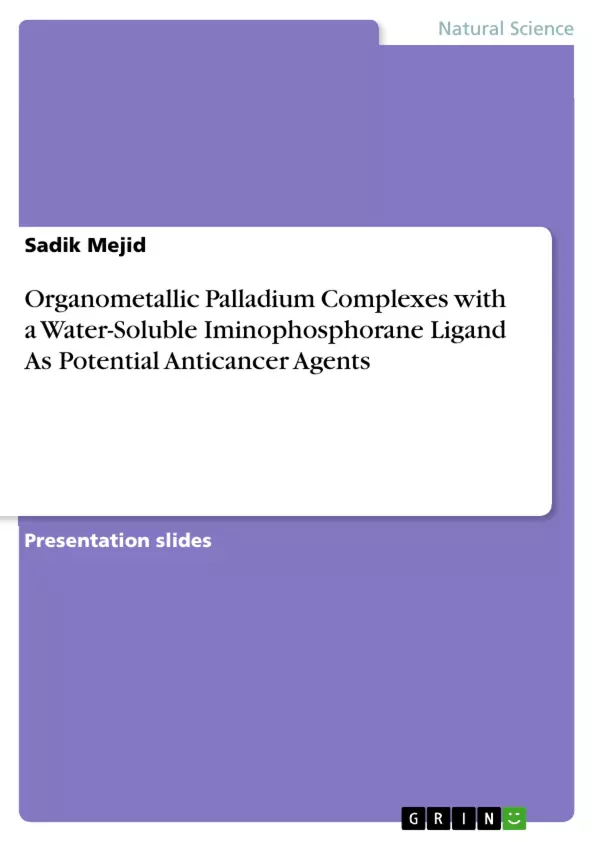Seminar Presentation in the subject "Inorganic Chemistry" with the title "Organometallic Palladium Complexes with a Water-Soluble Iminophosphorane Ligand As Potential Anticancer Agents". With the following contents:
-The problems of the currently used anticancer drugs;
- Palladium derivatives as an alternative to Platinum-based compounds;
- The first Water-Soluble Iminophosphorane Ligand;
- Preparation of Water-Soluble Ligand 1;
- Stability of Compounds in Solution;
- Cytotoxicity IC50 (μM) of Cisplatin, Ligand 1, Phosphine Oxide, TPA=O, and Metal Complexes 2-8 in Human cell lines;
- The Annexin V Binding Assay;
- Activity of Compounds 2 or 3 (50 μM) and Cisplatin against apoptosis-resistent cells;
- Chromosomal DNA and Plasmid DNA;
- Interactions of 2 and 3 with Plasmid DNA Using Electroforesis Mobility Shift Assay (EMSA);
- Interaction with Human Serum Albumin;
- Stern-Volmer plot for quenching with ligand 1 and compounds 2, 3, and 5 – 8 and cisplatin;
- Advantage over Cisplatin;
- Summery
Inhaltsverzeichnis (Table of Contents)
- The problems of the currently used anticancer drugs
- Palladium derivatives as an alternative to Platinum-based compounds
- The first Water-Soluble Iminophosphorane Ligand
- Preparation of Water-Soluble Ligand 1
- CO-group stabilize 1, otherwise in contact with H2O or Polar solvent it would break down to the corresp. Amine and phosphine oxide
- Stability of Compounds in Solution
- Cytotoxicity
- The Annexin V Binding Assay
- Activity of Compounds 2 or 3 (50 μM) and Cisplatin against apoptosis-resistent cells
Zielsetzung und Themenschwerpunkte (Objectives and Key Themes)
This seminar presentation explores the potential of water-soluble organometallic palladium complexes with an iminophosphorane ligand as anticancer agents. It addresses the limitations of existing platinum-based anticancer drugs and proposes palladium derivatives as a viable alternative. The presentation discusses the design and synthesis of a novel water-soluble iminophosphorane ligand, its coordination chemistry with palladium, and the resulting complex's stability and cytotoxic activity.
- Challenges of current anticancer drugs
- Palladium complexes as potential anticancer agents
- Synthesis and characterization of a water-soluble iminophosphorane ligand
- Stability and cytotoxicity of palladium complexes
- Potential of palladium complexes as a therapeutic alternative
Zusammenfassung der Kapitel (Chapter Summaries)
- The presentation begins by highlighting the limitations of current anticancer drugs, such as acquired resistance, limited spectrum of activity, and high toxicity leading to side effects. It then introduces palladium derivatives as a potential alternative to platinum-based compounds, leveraging the structural and thermodynamic analogy between platinum(II) and palladium(II).
- The presentation emphasizes the importance of stabilizing palladium(II) compounds to prevent their hydrolysis and ensure their stability in solution. It introduces a novel water-soluble iminophosphorane ligand as a potential stabilizing agent, possessing excellent properties for forming organometallic palladium(II) derivatives.
- The presentation details the preparation of the water-soluble ligand, emphasizing its stability in solution and its non-toxic nature. It highlights the crucial role of the carbonyl group in stabilizing the ligand against degradation in the presence of water or polar solvents.
- The presentation presents data on the stability of various palladium complexes in solution, demonstrating their long-term stability via 31P-NMR analysis. This section provides insights into the ligand's ability to stabilize palladium complexes over extended periods.
- The presentation explores the cytotoxic activity of the synthesized palladium complexes against various human cell lines. It compares their IC50 values with that of cisplatin, demonstrating promising anticancer activity for certain palladium complexes.
- The presentation introduces the annexin V binding assay as a method for detecting apoptosis, which involves the externalization of phosphatidylserine (PS) on the plasma membrane. It explores the activity of palladium complexes against apoptosis-resistant cells, highlighting their potential to overcome resistance mechanisms.
Schlüsselwörter (Keywords)
The main keywords and focus topics of this seminar presentation include organometallic palladium complexes, anticancer agents, water-soluble iminophosphorane ligand, stability, cytotoxicity, apoptosis, and therapeutic potential.
- Arbeit zitieren
- Sadik Mejid (Autor:in), 2014, Organometallic Palladium Complexes with a Water-Soluble Iminophosphorane Ligand As Potential Anticancer Agents, München, GRIN Verlag, https://www.grin.com/document/475220



